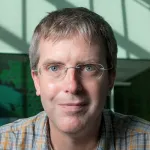
Stanford Report - February 18th, 2009 - by Cassandra Brooks
Current treatments for diseases like cancer typically destroy nasty malignant cells while also hammering the healthy ones. Using new advances in synthetic biology, researchers are designing molecules intelligent enough to recognize diseased cells and leave healthy cells alone.
"We basically design molecules that actually go into the cell and do an analysis of the cellular state before delivering the therapeutic punch," said Christina Smolke, assistant professor of bioengineering, who joined Stanford University in January.
Using new advances in synthetic biology, researchers are designing molecules intelligent enough to recognize diseased cells and leave healthy cells alone.
"When you look at a diseased cell—e.g., a cancer cell—and compare it to a normal cell, you can identify biomarkers—changes in the abundance of proteins or other biomolecule levels—in the diseased cell," Smolke said. Her research team has designed molecules that trigger cell death only in the presence of such markers. "A lot of the trick with developing effective therapeutics is the ability to target and localize the therapeutic effect while minimizing nonspecific side effects," she said.
Smolke presented the latest applications of her lab's work at the American Association for the Advancement of Science (AAAS) meeting in Chicago on Feb. 13.
These designer molecules are created through RNA-based technologies that Smolke's lab developed at the California Institute of Technology. A recent example of these systems, developed with postdoctoral researcher Maung Nyan Win (who joined Smolke in her move to Stanford), was described in a paper published in the Oct. 17, 2008, issue of Science.
"We do our design on the computer and pick out sequences that are predicted to behave the way we like," Smolke said. When researchers generate these sequences inside the operating system of a cell, they reprogram the cell and change its function. "Building these molecules out of RNA gives us a very programmable and therefore powerful design substrate," she said.
Smolke's team focuses on well-researched model systems in breast, prostate and brain cancers, including immunotherapy applications based on reprogramming human immune response to different diseases. The researchers work directly with clinicians at the City of Hope Cancer Center (a National Cancer Institute designated Comprehensive Cancer Center in Duarte, Calif.) who have ongoing immunotherapy trials for treating glioma, a severe type of brain cancer.
"Our goal is to make more effective therapies by taking advantage of the natural capabilities of our immune system and introducing slight modifications in cases where it is not doing what we would like it to do," Smolke said. She hopes to translate her technologies into intelligent cellular therapeutics for glioma patients in the next five years. "That's a very optimistic view," she said. "But so far things have been moving quickly."
The broader implications for using intelligent molecules in immunotherapy and gene therapy seem limitless. Researchers and doctors can use this approach by targeting a specific cellular function or behavior they want to control in a particular disease. Then they can identify signals indicative of viral infection, host immune response or drugs the clinician is administering and engineer the molecules to change the cell function in response to those signals.
"In a lot of therapies, you have nonspecific side effects or you're balancing the desired effect of the therapy on diseased cells or infection with its undesired effects on the entire host," Smolke said. Current chemotherapy treatments for cancer, and even many gene therapies, have drastic and debilitating consequences for patients. The designer molecules provide a whole new targeting accuracy that should mitigate these side effects.
"This is all very front-end work," Smolke said. "We've just started to move these foundational technologies into these sorts of downstream medical applications, and so there is a lot to learn—which makes it that much more exciting."
Smolke's work is funded by the National Institutes of Health, National Science Foundation, Department of Defense and Beckman Foundation.
At the AAAS meeting, Smolke presented her work alongside Drew Endy, an assistant professor of bioengineering at Stanford University, as part of the Synthetic Life symposium.
Endy, who joined Stanford last fall, discussed the societal and safety implications of molecular synthesis technology. This includes the consequences of researchers moving toward building registries for standard biological parts and the education aspects of iGEM—an international forum where student teams compete to design and assemble engineered machines using advanced genetic components and technologies—which has led to the training of a new generation of scientists and bioengineers. Stanford will be hosting its first iGEM team this year.
Endy also discussed his efforts, along with colleagues, to start fabrication facilities focused on churning out libraries of open-access biological parts and the resulting implications for biological engineering.

